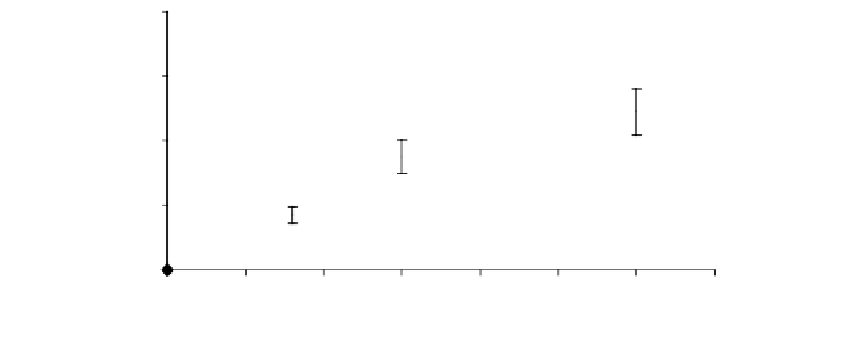Biomedical Engineering Reference
In-Depth Information
platinum wire acted as the counter electrode and a screen-printed electrode served as both
the reference and the working one. The screen-printed rhodium-graphite electrodes were
produced using a modified protocol according to (70,71). The area of the working
electrode was 2
10 mm.
The chronoamperometry was employed to verify the possibility of producing an
amperometric sensor to detect clozapine using cytochrome P4501A2. Aliquots of clozap-
ine (40
M in methanol) were added to the reaction mixture to obtain an amperometric
response curve. Figure 9.6 shows the resulting current as a consequence of constant
potential. It is observed that raising the clozapine concentration increased the response
current. These results indicate that it is possible to detect the concentration of clozapine,
free in solution, in the 20-300 nM range. This sensitivity is sufficient for routine meas-
urements, since the therapeutic range of clozapine in plasma is between 0.16 and 1.83
M
(50-600 ng/ml) (72-74).
The results underline that the LB technique can be used to immobilize molecules of
cytochrome P450 onto solid supports in a stable and reproducible way and to employ
heme-protein structures as sensitive elements in biosensors. Nevertheless, to detect
clozapine by electrochemical method we have found that, since we are dealing with a
low-grade cytochrome, it appears more advantageous to use cytochrome P4501A2
entrapped in gel matrix. The data demonstrated that utilizing both types of systems (LB
film and gel matrix) the presence of styrene, cholesterol, and clozapine employing
cytochrome P4502B4, P450SCC, and P4501A2, respectively, could be properly detected.
These results are encouraging for their possible future applications in the medical and
ecological fields.
In conclusion, due to the very attractive pleiotropic properties of the heme-enzymes,
P450s cytochrome isoforms confirm their potential to be used as sensing elements for a
wide range of organic substances. It is worth noticing, however, that even if the LB or LS
films appear to yield the best stable working conditions, the sensor technology may yield
optimal results also with other immobilization techniques, such as solution casting
improving cholesterol sensing to the range 11.5-1.2 mg/dl without gold nanoparticles (8)
and to the range 2.7-0.4 mg/dl with gold nanoparticles (68) in presence of 200
g of
P450scc on the electrode.
8
6
4
2
0
0
50
100
150
200
250
300
350
Clozapine (nM)
FIGURE 9.6
Current response in function of the concentration of clozapine (20 nM in methanol) added to cytochrome
P4501A2 gel-matrix, utilizing s.p.e. in 10 mM K-phosphate buffer, pH 7.4. The working electrode was poised at
U
-600 mV.





